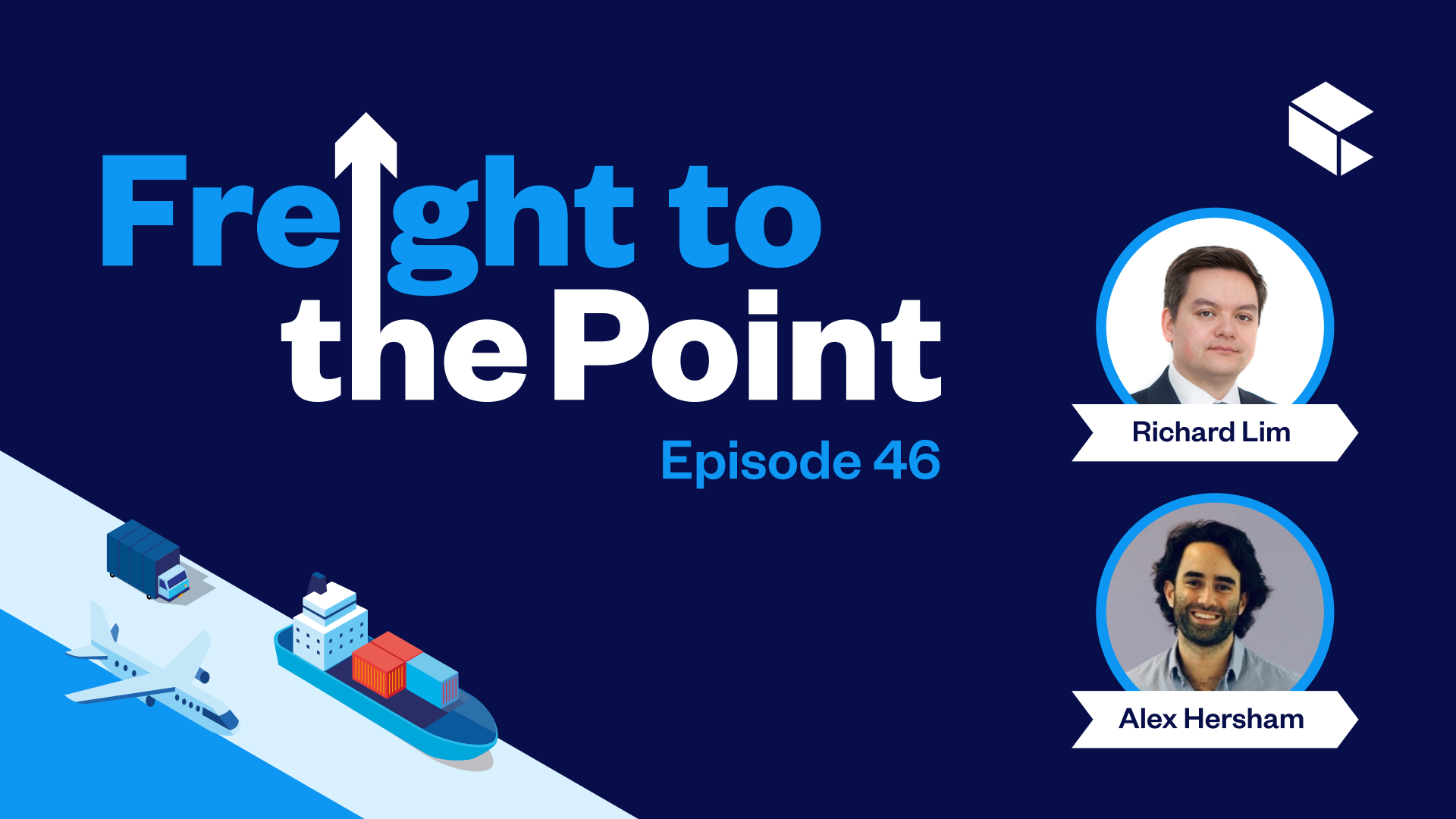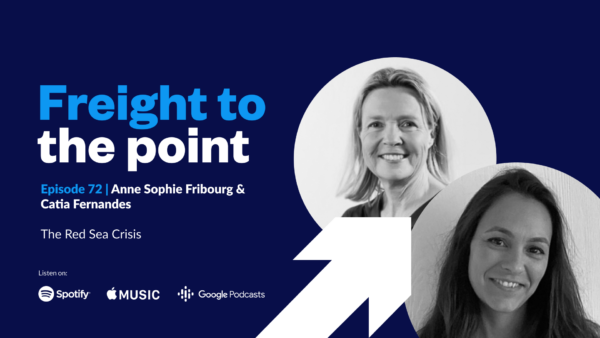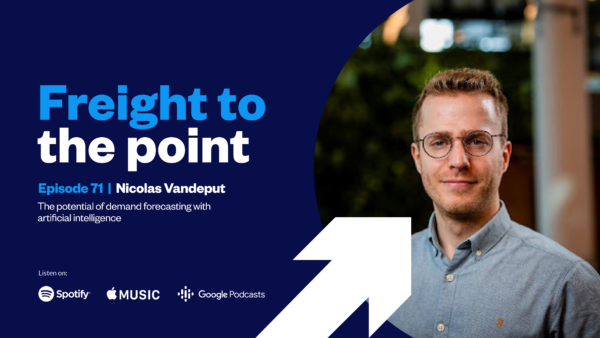Episode 46:
What's next for consumer demand? Part 2
See all episodes

How are consumers reacting to economic headwinds?
“At a very high level, the picture that we are seeing is that inflation will drive top level growth in the industry. We expect retail sales to hold up, but that’s being driven by inflation.”
For this episode of Freight to the Point, we’ve featured Part 2 of our Navigate session ‘What’s next for consumer demand?’ with Alex Hersham and Richard Lim, Chief Executive of Retail Economics.
They discuss:
- Recessionary behaviours in consumers
- What the future of retail looks like
- How businesses should prepare in the event demand increases
Richard Lim
Richard is the CEO at Retail Economics and previously headed up the ‘Retail Insight and Analytics’ team at the British Retail Consortium. Before that, he worked in mergers and acquisitions for Citi Group. He has a wealth of experience in data analytics, consumer research and macroeconomics, and is skilled in generating actionable insights for clients. Richard is based in London and has a keen interest in Behavioural Game Theory.
Resources
Episode 45: What’s next for consumer demand? Part 1
What can economic indicators tell us about what’s next for supply chains?
Hi, and welcome to another episode of Freight to the Point. This week, we’re hosting another session from Navigate, which we held in February. For this episode, we are featuring part two of 2023, What’s Next for Consumer Demand? Where Alex Hersham, Zencargo’s CEO and Co-founder, is joined by Richard Lim, Chief Executive at Retail Economics. Previously, in part one, they covered what’s happened in the economy and how businesses have reacted with their inventory levels. And for part two, Richard and Alex talk about recessionary behaviours and consumer demand. Hope you enjoy the episode.
Alex Hersham:
It really gets me curious about what the market might look like in Q2. Because if we get to the middle of Q2, and to your point, if trading is holding up stronger, or if there’s an expectation that we’re from the UK, the coronation coming up, people have started to get excited about what life after Easter might look like from a demand perspective, I do wonder if we’re going to start to see that inventory overhang quite quickly turn into people thinking about, how do they get their hands on more inventory? Which leads us to the next question, Richard, do you have any predictions on what demand might look like over the course of the year?
Richard Lim:
So we’re still relatively cautious and this slide really just demonstrates that there are so many different moving parts in terms of what we expect to happen throughout the next 12 months. At a very high level, I think the picture that we are seeing is that inflation will drive top level growth in the industry, so we expect retail sales to hold up, but that’s being driven by inflation. So our forecasts are for retail sales to be around three and a half percent for 2023, but that being driven by inflation, so volumes are likely to be tested and likely to be down on previous years. But like I say, it’s quite a mixed picture across the industry. And so there are some parts of the sector still suffering from a hangover impact, whether it was lockdown or whether it was people on furlough. It’s really disrupted the natural sales cycle within some specific sectors. And so we are still seeing the impact of that play out.
An example of that would be within furniture and flooring, where actually there’s quite significant support with furniture and flooring sales throughout the pandemic and people were at home and people are focused on improving their living environments and things like that. And so there are areas where there was a significant amount of demand that was pulled forward during that period and we are still seeing the negative consequences of that demand being pulled forward into this year. But like I say, this slide really demonstrates that there’s lots of different moving parts. The ones that I would pick out, I would pick out some of them on the consumer retailer side. I think we will continue to see the flights of value. So I think that consumers will continue to prioritise lower costs and they’ll be willing to sacrifice some of the other value attributes that they attach value to when they’re looking to purchase products. So essentially they’ll sacrifice potentially lower quality in exchange for lower costs, the experience in exchange for lower cost or even convenience as well for lower cost.
So I think we’ll continue to see this flights of value with people trading down to cheaper brands, to cheaper retailers, to the discounters. I think we’re likely to see those recessionary behaviours lead into a lot of that as well. From a retailer point of view, I think the emphasis will be really on protecting profitability. We’ve seen margin erosion across the last decade, and so there will be continued intense focus on profitability for retailers and that is going to have an impact on their operating models. So as we head into this year, what we’ve seen is from what our research shows, is that there’s four really distinct consumer cohorts that have emerged, which are shown on this slide on the left-hand side. And so what we’ve seen is what we’ve labelled over a third of consumers as financially distressed. And so this is a group of consumers that are genuinely financially distressed and they’re looking to cut back their spending across pretty much all elements.
They’re typically the least affluent households, they’re typically younger consumers, but they’re really looking to try to cancel purchasing products where they’re not essentials. Another group that we’re seeing is what we call the squeeze spenders. So this is a quarter of consumers that they will continue to spend, but they’re more likely to lean on debt in order to maintain that level of lifestyle. They’re typically middle-aged consumers. They’re more likely to channel hop as well. They’re more likely to be an omnichannel shopper that will search out the best deals, whether that’s online or whether that’s in store. So this is an interesting group of consumers that are less loyal to particular channels. We’ve labelled a quarter of consumers, 25% of consumers as comfortably cautious.
And I think this is an interesting group of consumers, because they’re cutting back more out of emotional drivers. So they do have the financial means to continue to purchase where they want to, but their confidence has been slightly damaged. They’re looking to cut back where they can. But they will continue to buy across certain product categories where there’s strong demand. And what that leaves is 14% that we call financially immune. So this is essentially 14% of consumers that have a keep calm, carry on attitude. The cost of living crisis hasn’t really affected their spending habits and they will continue to purchase irrespective of what’s happening in the wider economic environment. I think this is a really interesting group because what’s important is of course they spend more and so if you look at the group of households, if you’ve got the top 20% of households, they’re actually responsible for 40% of consumer spending.
So this is a really important group that are relatively insulated from the impact of the cost living crisis. They are particularly loyal to particular brands when it comes to luxury products as well. And so it’s an interesting group to identify for retailers and brands when they’re reaching out with their marketing communications and having a much more tailored personalised approach to their customer base and also trying to win new consumers as well. So across that landscape, what we see is that there are particular parts of the industry that will be affected the most and what that graph shows on the right-hand side is essentially, the cutback landscape where we see areas that are likely to see larger amounts of substitution and larger delays in spending across areas that are more typically associated with discretionary spending. So some of those areas will be around recreation and culture, around coffee shops and cafes and some of those areas.
And then there are other areas where we are likely to see more defensible spending, so food and drink being one of those areas. But the consumers would be more likely to trade down to cheap alternatives. So within food and drink as being an example, we’ve seen a big shift towards the discounters. This is a really clear example of consumers trading down. And actually if you look at the discounters within food and drink, they’ve seen a significant acceleration in their market share over the last few years, because of these recessionary behaviours that have emerged towards the end of the last year, and we expect to continue heading into this year as well.
Alex Hersham:
And so as we move… This is very interesting by the way, Richard. And that graph on the right, I think is fascinating to look at and in more detail. So maybe we can share some posts on LinkedIn afterwards, so people can really zoom in. Like I say, that analysis is really fascinating. So what will the future of retail look like?
Richard Lim:
So a big question, a big question. I think what we’re likely to see there are a number of short term trends. So if we consider that question in context of what we’re likely to see over the next 12 months or so, I think we’re likely to see polarisation within the sector. I think we’ll continue to see consumers trading down to cheaper alternatives, cheaper retailers, private label, cheaper brands. I think where possible consumers will delay their purchases. And so we’ll see this polarisation in the market, where the discounters will see this as an opportunity to reach out to new customers, acquire new customers and increase their market share during that period. And I think on the other side of the market, luxury spending will hold up pretty well, because some of the data that we’ve already seen, where essentially they are the most protected part of the market.
Alex Hersham:
I think it’s going to be a challenging year. I think the challenge comes because of the fact that there’s both downside risk, upside risk to consumer demands to different businesses. To your point in terms of the bifurcation of how businesses are going to trade to sourcing patterns. Hopefully supply chain can remain agile, because the more I speak to supply chain leaders, the more I hear the conscious thinking about, “Well, if things do rebound or if they don’t, how do we stay agile? How do we pull inventory closer? How do we not spend too much on air freight?” I think now would be a great time though to open up to some Q and A. So the first question Richard, maybe you want to start and then I can jump in afterwards. What are the steps businesses should be taking now to prepare for when demand increases and what role does technology play in this?
Richard Lim:
So I think the tactical strategies if you like, that businesses should be really focused on at the moment, is having a forensic look at their profitability. So looking at how they can drive down costs, drive better efficiencies, create margin headroom within certain product categories, make sure that they can pivot their proposition to offer and really double down on their value proposition in some cases to try to attract new customers. And use this as potentially a way to reach out to new customers who in many parts of the market have become decoupled from the brands that they have been loyal to in the past, because of the shock of the cost of living crisis.
So in this sense it’s really important for retailers to get ahead of the game in terms of introducing those strategies to drive better efficiencies so when we come out of the recession, they’re in a really strong position to leverage the new customers that they’ve acquired and also reach out to new ones. Whether that’s more tailored than personalised marketing campaigns and things like that. I think tech technology absolutely will play a critical role in that. I think we’re genuinely on the beginning of a huge technological wave of progression here. So whether that’s AI that’s generating more efficient supply chains or using and utilising customer data more effectively, 5G quantum computing, there’s many aspects that are technological progression. But the digital transformation of retailers over the past five years and heading into the future is going to be the key differentiator of success for many of them.
Alex Hersham:
I totally agree. If I start with technology, I think you can’t escape the need for better end to end inventory management. You can’t escape the need for more collaboration to adjust lead times where possible. You can’t escape the need to connect that demand and inventory levels. So to essentially move those weekly trading meetings where everyone comes in on a Monday morning and tries to do as many pivots as possible. Something more real time, more dynamic and then layer on some of the other points that you mentioned. I think something else that supply chain leaders can be thinking about is, how do you innovate with your freight partner to give yourself more flexibility if we do see a rebound? So what are the CS solutions you should be thinking about? Should we be looking at, if we still procure in the Far East, is there a way to bring it into the Middle East as an example into a free zone, store it in that free zone, maybe there’s some trade finance options there, and then pull it in an air freight if needed?
These might seem convoluted, complicated things to look at, but personally when I study historic restocking environments, you see two things happen. You see ocean freight rates go up a bit, definitely not to where it was before in the past 18 months. But we could easily see ocean freight rates go up materially from where we are. But you see air freight rates out of the Far East, out of the main sourcing regions go up significantly, because capacity doesn’t adjust as quickly as demand does. And so thinking about how can you be flexible with your partner, how can you pre-plan for a sea air, for a light touch warehousing solution in a free zone, et cetera, I think are conversations that everybody should be having. And if you have a good supply chain partner, they should be well-equipped to have those conversations with you.
The next question that’s come in, is around interest rates. Banks are increasing interest rates and a lot of hyperinflation is on the way. How can we as an importer and a wholesaler prepare for that? What are some methods? I mean you touched on that Richard, I think a little bit before with your skew profit strategy, overall cost rationalisation, never waste a good crisis. But is there anything specific to the interest rate environment that people can prepare for?
Richard Lim:
It is difficult. The obvious answer is making sure that you’ve hedged in advance. And so a lot of our clients are hedging interest rates 12 months in advance. Just making sure that they’ve got the certainty of whether it comes down to fundraising or whether it comes down to the repayment of tax or just making sure that they’ve got the certainty of interest rates volatility that they don’t want to get caught up in. And obviously related to that is hedging around currencies as well. And so making sure they’ve got certainty hedged against the currency that they’re denominating in terms of their major supplier routes, again just to create some certainty. But there’s limited levers that you can pull in this environment.
Alex Hersham:
Yeah. A lot of conversations that we’ve been having are, “Are interest rates now high and therefore coming down in a few years time? Or if you look back before 2008, are we just at relatively normal interest rate levels? And will central banks want to have interest rates in this range, maybe slightly lower, so that if we enter another fiscal crunch in a few years time they at least have a bit of flexibility to push them straight down and stimulate the monetary policy?” So I don’t think it’s going to be easy to look at where interest rates are going. Hopefully if you look at you’re a sterling based import or a Euro based importer and you’re buying dollars, hopefully as things settle down and as confidence comes back, both of those currencies could strengthen a little bit.
We have another question here. I don’t know, Richard, if you’ve been hearing from any business leaders around sourcing movements to near sourcing. From my perspective, what I’ve been seeing is a lot of businesses actively looking at this, looking at how they can reduce scope in China, but also increase scope, so that strategically reduces China and look at other Southeast Asian or Far East economies to import from. But also strategically what’s the role of Turkey? What’s the role of Portugal or even the UK in terms of sourcing patterns? So those seem like two connected points, but they’re different. One is a geopolitical risk, one is having a mix of near and far sourcing. What are you hearing, Richard?
Richard Lim:
I definitely think that what happened throughout the pandemic is that they’re really highlighting the fragility of supply chains. And so retailers were looking at diversifying suppliers, diversifying supplying countries, looking at where they can make sure that they’ve got that continuity. Part of that is about trying to near shore and that’s certainly some of the conversations that we’ve had with our clients, just to try to shorten supply chains and try to get a bit more flexibility in that area. I do think also that there’s an ESG angle to this and I think that there’s pressure for some retailers to look at their supply chains and try to bring them closer to home, to try to reduce carbon emissions as well.
Alex Hersham:
Thank you very much. We’re going to move on from this session. But Richard, I think that was really interesting. Your insights were fantastic. Those graphs were great. I was definitely squinting to look at more information and maybe we can convert that into posts as mentioned and send it out to the audience and put it on LinkedIn. But thank you very much.
Outro:
Thanks for tuning into part two of this episode. We hope you enjoyed it. If you did like the episode, please don’t forget to subscribe and share with your network. And if you have any questions or feedback, please don’t hesitate to contact us on LinkedIn. We’d love to hear from you. But until next time, goodbye.

Episode 72: The Red Sea Crisis
In the latest episode of Freight to the Point, we’ve featured our most rec...

Episode 71: The potential of demand forecasting with artificial intelligence
In the most recent instalment of Freight to the Point, Lucie Phillips, Zen...

Episode 70: Rates: What's next for 2024?
As we prepare for the year ahead, it's crucial to consider the three pillars...

